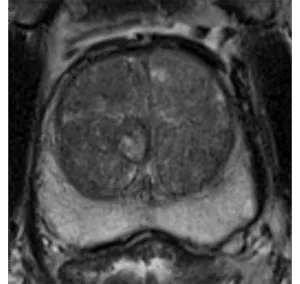Prostate Volume Calculator + PSA Density Calculator

References:
- Stanzione A, Ponsiglione A, Di Fiore GA, et al. Prostate Volume Estimation on MRI: Accuracy and Effects of Ellipsoid and Bullet-Shaped Measurements on PSA Density. Acad Radiol. 2021;28(8):e219-e226. doi:10.1016/j.acra.2020.05.014
- Haas M, Günzel K, Miller K, Hamm B, Cash H, Asbach P. Is the Ellipsoid Formula the New Standard for 3-Tesla MRI Prostate Volume Calculation without Endorectal Coil?. Urol Int. 2017;98(1):49-53. doi:10.1159/000448593
- Littrup PJ, Williams CR, Egglin TK, Kane RA. Determination of prostate volume with transrectal US for cancer screening. Part II. Accuracy of in vitro and in vivo techniques. Radiology. 1991;179(1):49-53. doi:10.1148/radiology.179.1.2006303
Related Calculators:

More About the Prostate Volume Calculator & PSA Density Calculator
The Prostate Volume Calculator and PSA Density Calculator are essential tools in urologic and radiologic evaluation. They help clinicians quantify prostate size and relate it to prostate-specific antigen (PSA) levels, providing more context to laboratory and imaging data. These calculators support clinical decisions in the diagnosis, monitoring, and management of prostate conditions such as benign prostatic hyperplasia (BPH) and prostate cancer.
By combining prostate gland volume with PSA levels, these tools generate measurable insights that improve diagnostic precision and reduce unnecessary biopsies. They are widely used across outpatient settings, MRI interpretation workflows, and follow-up evaluations in prostate disease management.
Ellipsoid Prostate Volume = π/6×DAP×DL×DT
Bullet shaped Prostate Volume = π/4.8×DAP×DL×DT
DAP= Maximum diameter in the Anterior-Posterior plane
DL= Maximum diameter in the Longitudinal plane
DT= Maximum diameter in the Transverse plane
Why Prostate Volume Matters
Prostate volume affects both PSA interpretation and treatment strategies. An enlarged prostate can elevate PSA levels without malignancy, so understanding gland size helps distinguish benign from potentially malignant causes of PSA elevation. The prostate volume calculator uses ultrasound or MRI measurements to estimate gland size, often via the ellipsoid formula (width × height × length × 0.52).
Key Benefits of Measuring Prostate Volume
- Improves accuracy in interpreting PSA values.
- Supports risk stratification and treatment selection in BPH and prostate cancer.
- Helps track changes in gland size during therapy or active surveillance.
- Assists in planning prostatectomy or radiation therapy.
Understanding PSA Density
While PSA levels are a cornerstone of prostate cancer screening, they can be influenced by factors other than malignancy. The PSA Density Calculator refines interpretation by relating PSA concentration to prostate volume, offering a more individualized risk assessment.
Formula:
PSA Density = PSA (ng/mL) ÷ Prostate Volume (cm³)
PSA density contextualizes PSA values: a high PSA in a large prostate may not be concerning, while a modest PSA in a small prostate may warrant attention. A common clinical cutoff is 0.15 ng/mL/cm³, above which malignancy risk increases.
Advantages of PSA Density Assessment
- Improves cancer risk prediction in patients with intermediate PSA values (4–10 ng/mL).
- Reduces unnecessary biopsies in patients with large benign prostates.
- Provides additional guidance in active surveillance protocols.
- Enhances diagnostic specificity when combined with MRI findings.
Integrating Imaging and PSA Density
Modern prostate MRI, especially multiparametric MRI (mpMRI), allows detailed volume assessment and zonal anatomy evaluation. Combining MRI-derived volume with PSA levels improves diagnostic accuracy, particularly when deciding whether a biopsy is needed. This integrated approach supports “MRI-first” diagnostic pathways now recommended in many clinical settings.
Clinical Applications
The prostate volume and PSA density calculators are valuable in several contexts:
- Evaluating elevated PSA results and determining need for biopsy.
- Guiding active surveillance decisions in low-risk prostate cancer.
- Monitoring BPH progression and response to therapy.
- Correlating MRI-based PI-RADS scores with PSA-derived metrics for risk refinement.
Evidence and Guidelines
Major urological societies, including the American Urological Association (AUA) and the European Association of Urology (EAU), endorse PSA density as an adjunct to PSA testing in biopsy decisions and active surveillance. Studies show that PSA density increases specificity for prostate cancer detection, especially when integrated with mpMRI findings.
Considerations and Limitations
Accurate calculation depends on reliable imaging and consistent measurement technique. PSA levels can also fluctuate due to infection, inflammation, recent ejaculation, or medical interventions. Therefore, PSA density should be interpreted within the full clinical context, not as a standalone diagnostic metric.
Conclusion
The prostate volume and PSA density calculators offer a structured and evidence-based way to interpret PSA results and gland size. By integrating anatomical and biochemical data, they help clinicians tailor decisions for each patient, supporting early detection, targeted intervention, and ongoing management of prostate health.
These calculators are best used alongside clinical findings, imaging, and patient history to provide the most accurate and personalized care possible.
Frequently Asked Questions (FAQ)
- How accurate is prostate volume measurement?
Transrectal ultrasound (TRUS) provides reliable prostate volume estimates, particularly when the gland shape is regular. MRI generally offers greater precision, especially for irregular or asymmetric prostates, but both methods are clinically valid for calculating PSA density. - What is a normal prostate volume?
In adult men, a prostate volume of approximately 20–30 cm³ is considered normal. Enlargement beyond 30–40 cm³ is often associated with benign prostatic hyperplasia (BPH), though size alone doesn’t indicate cancer risk. - What PSA density value is concerning?
Although there are no definite cut off levels, a PSA density above 0.15 ng/mL/cm³ is commonly associated with increased risk of prostate cancer and may warrant biopsy, especially if supported by suspicious MRI findings or clinical risk factors. - Can PSA density replace MRI or biopsy?
No. PSA density is a complementary parameter. While it helps refine risk estimates, it should always be interpreted with imaging findings, physical examination, and other clinical indicators before deciding on biopsy or treatment. - Does prostate size affect PSA levels?
Yes. Larger prostates naturally produce more PSA, which can elevate levels even in the absence of cancer. That’s why adjusting PSA by gland volume (using PSA density) gives a more individualized assessment. - How often should PSA density be checked?
PSA and prostate volume are typically reassessed annually during routine prostate health evaluations or more frequently in active surveillance programs, depending on the clinical context and prior findings.






Thank you for this very helpful site.
Saves a lot of my reading time and improved my accuracy
please check Prostate volume calculator. The calculation tool is incorrect.
Thank you for your kind feedback Dr. Doss. The issue has been resolved.